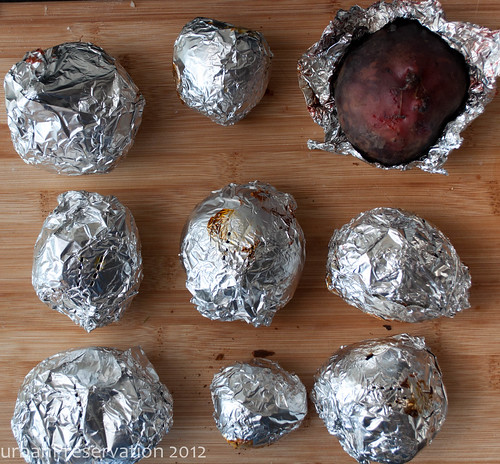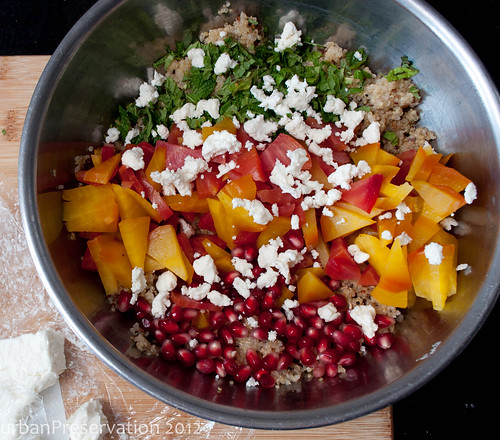
Then, in college, I studied abroad in Australia for a semester. Aussies have a weird habit of putting a slice of canned or roasted beet on their burgers instead of tomato. In fact, the first time I had a (veggie) burger in Australia, I remarked that the tomato was unusually sweet and not mealy, especially since the place I was in was a kind of dive-y bar, before being informed that it was in fact a slice of beet. This is actually a pretty genius substitution since the beet provides the sweetness and juiciness that the tomato is supposed to but which is often fails to provide. That was the first time I realized that beets could in fact be delicious and I have since convinced many people to embrace them, including my somewhat-skeptical parents.
The trick to beets, as with many vegetables, is to roast them. The roasting really deepens the sweetness of the beets and it avoids the unpleasant off flavors that can come out when you boil them. I prefer the golden and candy-striped (or chiogga) beets because they are less sweet than the red ones you typically find in stores. They can be hard to find but they’re definitely worth it.

Once you’ve roasted them, there are a lot of things you can do with beets. I bought a bunch with a particular recipe in mind (ed: it was this one) but I bought more than I needed so I had to figure out what to do with a few extra. I’ve been trying to challenge myself to come up with more interesting grain salad recipes and this seemed like an excellent opportunity. What came out of it was not so much a recipe as a method – good grain salads need chew, body, and some crunch and the combination of tangy-salty-sweet-herbal is always a good way to keep your palate interested. Spicy works too but that will have to wait for a different version of this salad.

I knew quinoa would add a nice chewiness and grassy flavor and the beets would add a bit of heft and sweetness. What I needed now was something salty, something tangy, and something a little herbal. I used feta for the salt (although goat cheese works too, as evidenced by the ubiquitous beet-and-goat-cheese salad on Northern California menus). The tangy came from a lemon vinaigrette and some pomegranate seeds, which also added a little crunch. And I chose mint for the herb since it pairs really well with beets. I served this with hummus and pita bread to create a balanced meal but it’s easy to switch up this recipe, serve it with another kind of protein, and call it dinner. I know I will.
Quinoa Salad with Roasted Beets, Feta, Pomegranate, and Mint
2-3 beets, preferably golden or candy-striped
1 cup quinoa
1-2 ounces of feta cheese, crumbled (about ¼ cup)
Seeds from half a pomegranate
1/3 cup freshly chopped mint
Juice of ½ a lemon
¼ cup good quality oil
Salt and pepper to taste
Preheat oven to 400F. Wrap each beet in foil and place the wrapped beets in a baking pan to catch any juice that tries to escape. Roast for 1 hour, turning at least once to prevent burning on the spot touching the pan. Unwrap and leave until cool enough to handle, then peel each beet.* Cut beets into a medium dice – cut in half, cut each half in half or thirds depending on size, then slice 1/8 inch thick. Season with salt.
Place quinoa and 2 cups of water into a medium size sauce pan and bring to a boil. Cover, turn heat to low, and cook for about 15 minutes. Quinoa should not be crunchy when finished and the many of the rings around each grain should have separated. Let cool to room temperature.
Combine quinoa, lemon juice and oil in a serving bowl. Add salt and pepper to taste, keeping in mind that the feta will add additional salt. Arrange beets, feta, mint, and pomegranate seeds on top. Mix just before serving to prevent beets from dying quinoa pink and gold. Serve cold or at room temperature.
*I find it much easier to peel beets after they’re roasted. I also find this easier, and less messy, than the traditional method of rubbing each beet with a (paper) towel to remove the skin.
No comments:
Post a Comment